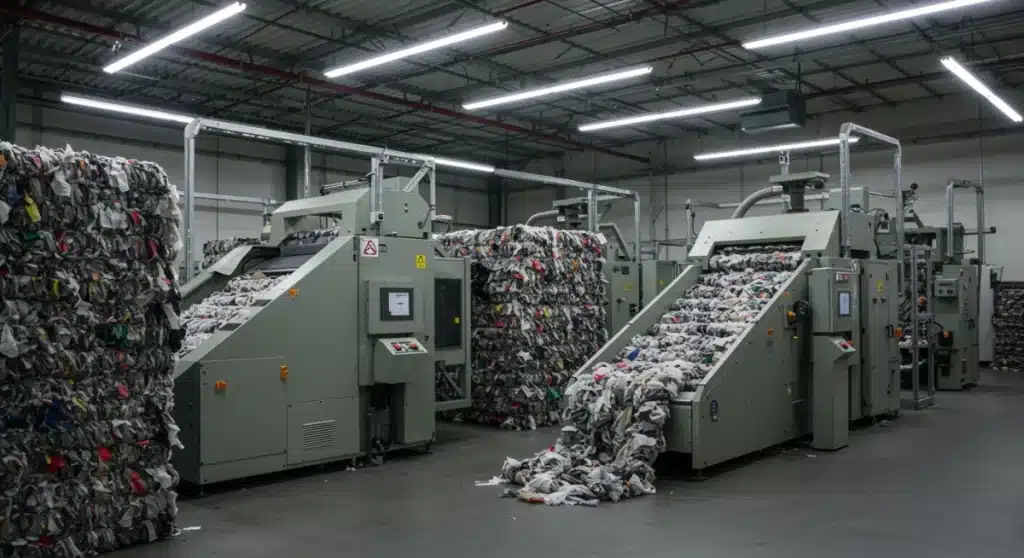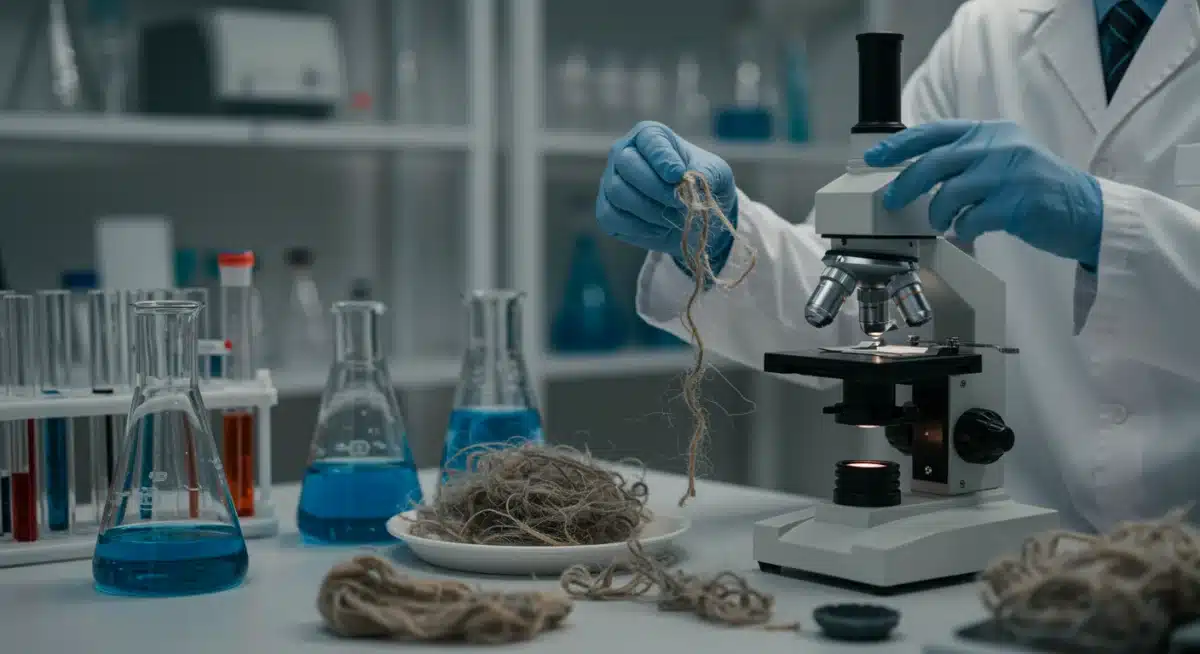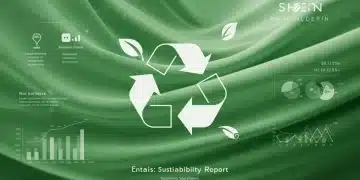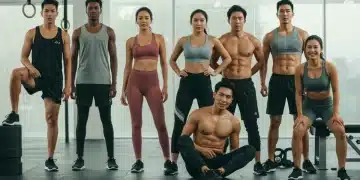Textile Recycling Technologies to Reshape Fashion by 2025

Anúncios
New textile recycling technologies are rapidly advancing, promising to fundamentally transform fashion production by 2025 through innovative processes that convert waste into valuable resources, fostering a more sustainable and circular industry.
The fashion industry, long criticized for its environmental impact, is on the cusp of a profound transformation. A news update reveals how new textile recycling technologies are not just incremental improvements but are set to fundamentally reshape fashion production by 2025. This shift promises a future where waste is minimized, resources are conserved, and sustainability becomes an integral part of every garment’s lifecycle, offering a beacon of hope for a more responsible industry.
Anúncios
the urgent need for textile recycling innovation
The global fashion industry faces an undeniable challenge: an enormous volume of textile waste. Each year, millions of tons of clothing end up in landfills, contributing significantly to pollution and resource depletion. This unsustainable linear model, characterized by ‘take, make, dispose,’ is no longer viable in an era demanding environmental responsibility and circular economies.
Consumer awareness regarding fashion’s environmental footprint is growing, creating pressure on brands to adopt more sustainable practices. This pressure, coupled with increasing regulatory scrutiny, is catalyzing investment and innovation in recycling solutions. The urgency is palpable, with many stakeholders recognizing that a fundamental shift is required to secure the industry’s future.
Anúncios
the environmental cost of fast fashion
Fast fashion’s rapid production cycles and low prices have exacerbated the waste problem. Garments are often designed for short lifespans, leading to frequent disposal. This constant churn places immense strain on natural resources and generates substantial carbon emissions.
- Excessive water consumption in cultivation and dyeing
- High energy usage in manufacturing processes
- Pollution from chemical dyes and synthetic fibers
- Accumulation of non-biodegradable waste in landfills
The sheer volume of clothing entering and exiting the market demands a robust and scalable solution for end-of-life textiles. Without effective recycling, the environmental burden will only continue to escalate, making innovative technologies not just beneficial, but absolutely essential for mitigating these damages.
Addressing the pressing issue of textile waste is paramount for the fashion industry’s long-term viability. The current trajectory is unsustainable, making the development and implementation of advanced recycling technologies a critical imperative for environmental protection and resource management.
advancements in mechanical recycling techniques
Mechanical recycling, a traditional method, involves physically breaking down textile waste into fibers that can then be spun into new yarns. While historically limited by fiber degradation, recent technological advancements are significantly improving its efficiency and the quality of the output. These innovations are making mechanical recycling a more viable option for a wider range of textile waste.
The process typically involves sorting, shredding, and carding materials. The resulting fibers, often shorter than virgin ones, can be blended with new fibers or other recycled materials to create new fabrics. The key to its evolution lies in refining these stages to preserve fiber length and integrity, expanding its application beyond basic insulation or filler materials.
improving fiber quality and separation
New machinery and processes are enhancing the ability to separate different fiber types more effectively, which is crucial for maintaining the quality of the recycled output. Innovations in optical sorting and automated material identification are playing a significant role.
- Advanced shredding techniques minimize fiber damage
- Automated sorting systems increase purity of recycled materials
- Blended fiber separation technologies are emerging
- Improved carding processes yield longer, stronger recycled fibers
These improvements mean that mechanically recycled fibers can now be incorporated into higher-value textiles, reducing the reliance on virgin resources. This progress is essential for creating a more circular economy within the fashion sector, allowing materials to re-enter the production loop with minimal loss of quality.
The evolution of mechanical recycling, driven by sophisticated sorting and processing techniques, is transforming its potential. This method is becoming increasingly effective at converting textile waste into usable fibers, contributing significantly to sustainable fashion practices and reducing the industry’s environmental footprint.
the rise of chemical textile recycling solutions
Chemical recycling represents a groundbreaking frontier in textile sustainability, offering a solution to the limitations of mechanical methods, especially for mixed-fiber textiles. This approach involves dissolving textile waste at a molecular level, regenerating pure fibers that are often indistinguishable from virgin materials. It’s a game-changer for materials that were previously considered unrecyclable.
Unlike mechanical recycling, which can shorten fibers, chemical recycling breaks down polymers into their original monomers or oligomers. These can then be re-polymerized to create new, high-quality fibers. This technology holds immense promise for closing the loop on textile waste, especially for challenging blends like cotton-polyester.
innovative solvent-based processes
Several chemical recycling technologies are gaining traction, each with its unique chemical process. These often involve specific solvents that selectively dissolve certain fibers, leaving others intact or allowing for their separate recovery. This precision is vital for handling the complex compositions of modern garments.
- Cellulose regeneration for cotton and other natural fibers
- Depolymerization of polyester into its constituent monomers
- Solvent-based dissolution for mixed fiber separation
- Hydrothermal processes for breaking down complex textiles

These advanced chemical processes are crucial for creating a truly circular fashion system, enabling the recovery of high-quality raw materials from even the most complex textile waste streams. The ability to produce fibers of virgin quality from discarded clothing marks a significant step forward in sustainable fashion production.
Chemical recycling is emerging as a powerful tool in the quest for fashion sustainability. By breaking down textiles at a molecular level, it offers the potential to create high-quality, recycled fibers from diverse waste streams, addressing the limitations of traditional recycling methods and propelling the industry towards a truly circular future.
biotechnological approaches: enzymes and microorganisms
Beyond mechanical and chemical methods, biotechnology is introducing an exciting new dimension to textile recycling. This innovative field harnesses the power of enzymes and microorganisms to break down textile fibers, offering gentler and often more eco-friendly alternatives. These biological processes operate under milder conditions, potentially reducing energy consumption and the need for harsh chemicals.
Enzymatic recycling, for instance, uses specific enzymes to selectively degrade certain textile components, such as cellulose in cotton. This can separate different fiber types in blends or break down fibers into their building blocks for regeneration. Microorganisms are also being explored for their ability to consume and transform textile waste into new raw materials.
enzyme-assisted fiber separation and degradation
Enzymes are highly specific, making them ideal for targeted degradation of textile components. This specificity can be leveraged to separate blended fabrics, converting one component into a valuable resource while leaving the other intact. This precise action minimizes damage to the remaining fibers.
- Cellulase enzymes for cotton depolymerization
- Enzymatic hydrolysis for protein-based fibers like wool
- Bio-separation of polyester from cotton blends
- Reduced energy and chemical input compared to traditional methods
The development of industrial-scale biotechnological recycling processes is still in its early stages but holds immense promise. As research progresses, these biological methods could provide scalable, environmentally benign solutions for recovering valuable materials from complex textile waste, further diversifying the toolkit for sustainable fashion.
Biotechnological recycling, utilizing enzymes and microorganisms, offers a promising eco-friendly pathway for textile waste management. These methods provide precise and less energy-intensive ways to break down and separate fibers, contributing to a more sustainable and circular approach to fashion production.
integration of recycling into fashion supply chains
The true impact of new textile recycling technologies will only be realized through their seamless integration into existing fashion supply chains. This requires more than just developing the technology; it demands collaboration across the entire value chain, from designers and manufacturers to retailers and consumers. Building robust reverse logistics and infrastructure for collecting, sorting, and processing textile waste is paramount.
Brands are beginning to recognize the economic and reputational benefits of adopting circular models. This includes designing for recyclability from the outset, investing in recycling infrastructure, and educating consumers on proper disposal. The shift from a linear to a circular economy in fashion is a complex undertaking, necessitating systemic change and strategic partnerships.
designing for circularity and collection infrastructure
For recycling to be effective, garments must be designed with their end-of-life in mind. This means favoring mono-materials or easily separable blends, avoiding excessive embellishments, and ensuring material transparency. Simultaneously, efficient collection systems are vital to feed recycling facilities with sufficient, sorted feedstock.
- Implementing design for disassembly principles
- Standardizing material compositions for easier recycling
- Developing accessible consumer take-back programs
- Investing in automated sorting and collection centers
The successful integration of these recycling technologies hinges on creating a supportive ecosystem where materials flow seamlessly from consumption back into production. This collaborative effort will ultimately determine the pace and scale of fashion’s transformation towards a truly circular and sustainable future.
Integrating advanced recycling technologies into the fashion supply chain is critical for maximizing their impact. This involves a holistic approach, encompassing design for circularity, robust collection systems, and strong industry collaborations, to transition towards a truly sustainable and resource-efficient fashion ecosystem.
the economic impact and market opportunities
The widespread adoption of new textile recycling technologies is not merely an environmental imperative; it also presents significant economic opportunities and market advantages. As sustainability becomes a core consumer value, brands that embrace circularity can gain a competitive edge, attract new customers, and build stronger brand loyalty. Furthermore, reducing reliance on virgin resources can lead to greater supply chain resilience and cost efficiencies.
Investment in recycling infrastructure and technology is creating new jobs and fostering innovation within the green economy. The market for recycled fibers and materials is projected to grow substantially, offering new revenue streams and diversifying the textile industry. This shift signifies a move towards a more resource-efficient and economically stable fashion sector.
cost savings and new business models
By transforming waste into valuable inputs, companies can reduce raw material costs and mitigate price volatility associated with virgin resources. This economic incentive is a powerful driver for adopting recycling technologies. New business models, such as textile-as-a-service or closed-loop production, are also emerging.
- Reduced dependence on fluctuating raw material markets
- Creation of high-value recycled materials for premium products
- Development of new circular business models and services
- Enhanced brand reputation and increased consumer trust
The economic benefits extend beyond individual companies, contributing to a more robust and sustainable global economy. As these technologies mature and scale, they will unlock further efficiencies and opportunities, solidifying the role of recycled textiles as a cornerstone of future fashion production and consumption.
The economic implications of advanced textile recycling are profound, offering substantial market opportunities and cost savings. By fostering innovation and creating new business models, these technologies are not only driving environmental sustainability but also shaping a more resilient and profitable future for the fashion industry.
challenges and the path forward for sustainable fashion
While the promise of new textile recycling technologies is immense, their widespread implementation faces several challenges. These include the complexity of textile waste streams, the need for significant capital investment in new infrastructure, and the development of standardized sorting and processing methods. Overcoming these hurdles will require concerted efforts from industry, government, and consumers.
Furthermore, scaling these technologies to meet the vast demand of the global fashion industry is a considerable undertaking. Research and development must continue to refine processes, reduce costs, and expand the types of materials that can be effectively recycled. Education and awareness campaigns are also crucial to encourage consumer participation in take-back programs.
collaboration and policy support for circularity
Effective policy frameworks and industry-wide collaboration are essential to accelerate the transition to a circular fashion economy. Governments can incentivize sustainable practices through regulations, subsidies, and investment in recycling infrastructure. Industry consortia can foster shared knowledge and best practices.
- Developing coherent global policies for textile waste management
- Investing in research and development for emerging technologies
- Promoting cross-industry partnerships and knowledge sharing
- Educating consumers on recycling practices and sustainable consumption
The path forward for sustainable fashion is one of continuous innovation, collaboration, and commitment. By addressing the current challenges head-on and leveraging the full potential of these transformative recycling technologies, the fashion industry can truly reshape its production methods by 2025 and pave the way for a more environmentally responsible future.
Despite the challenges, the trajectory for sustainable fashion, powered by advanced recycling technologies, is clear. Continued collaboration, policy support, and sustained innovation are vital to overcome existing hurdles and fully realize the transformative potential of textile recycling for a circular and responsible industry by 2025 and beyond.
| Key Aspect | Brief Description |
|---|---|
| Mechanical Recycling | Physical breakdown of textiles into fibers; improved quality and separation techniques are expanding its use. |
| Chemical Recycling | Dissolves textiles at a molecular level to regenerate high-quality, virgin-like fibers, crucial for mixed materials. |
| Biotechnological Methods | Uses enzymes and microorganisms for gentler, eco-friendly fiber degradation and separation, offering a new frontier. |
| Supply Chain Integration | Requires collaboration, design for circularity, and robust collection infrastructure for widespread impact. |
frequently asked questions about textile recycling
The main types include advanced mechanical recycling, which improves fiber quality; chemical recycling, which breaks down textiles to their molecular components; and biotechnological methods, utilizing enzymes and microorganisms for gentle degradation.
By 2025, these technologies are expected to significantly reduce textile waste, decrease reliance on virgin resources, and enable a more circular production model. This will lead to more sustainable fashion options and a reduced environmental footprint.
Key challenges include the complexity of mixed textile waste, the need for substantial investment in new infrastructure, developing standardized sorting processes, and scaling technologies to meet global demand efficiently and cost-effectively.
With advancements in chemical and biotechnological recycling, regenerated fibers can often achieve quality levels comparable to virgin materials. Mechanical recycling is also improving, yielding better quality fibers suitable for a wider range of products.
Consumers can contribute by supporting brands using recycled materials, participating in take-back programs, properly sorting textile waste, and extending the lifespan of their garments through care and repair, fostering a circular mindset.
conclusion
The rapid evolution of textile recycling technologies signals a transformative era for the fashion industry, promising a future where sustainability is not just an aspiration but a fundamental operational principle. By 2025, these innovations are set to reshape production methods, significantly reducing waste and fostering a truly circular economy. While challenges remain, the combined efforts of technological advancement, industry collaboration, and informed consumer choices are paving the way for a more responsible and resilient fashion landscape.





